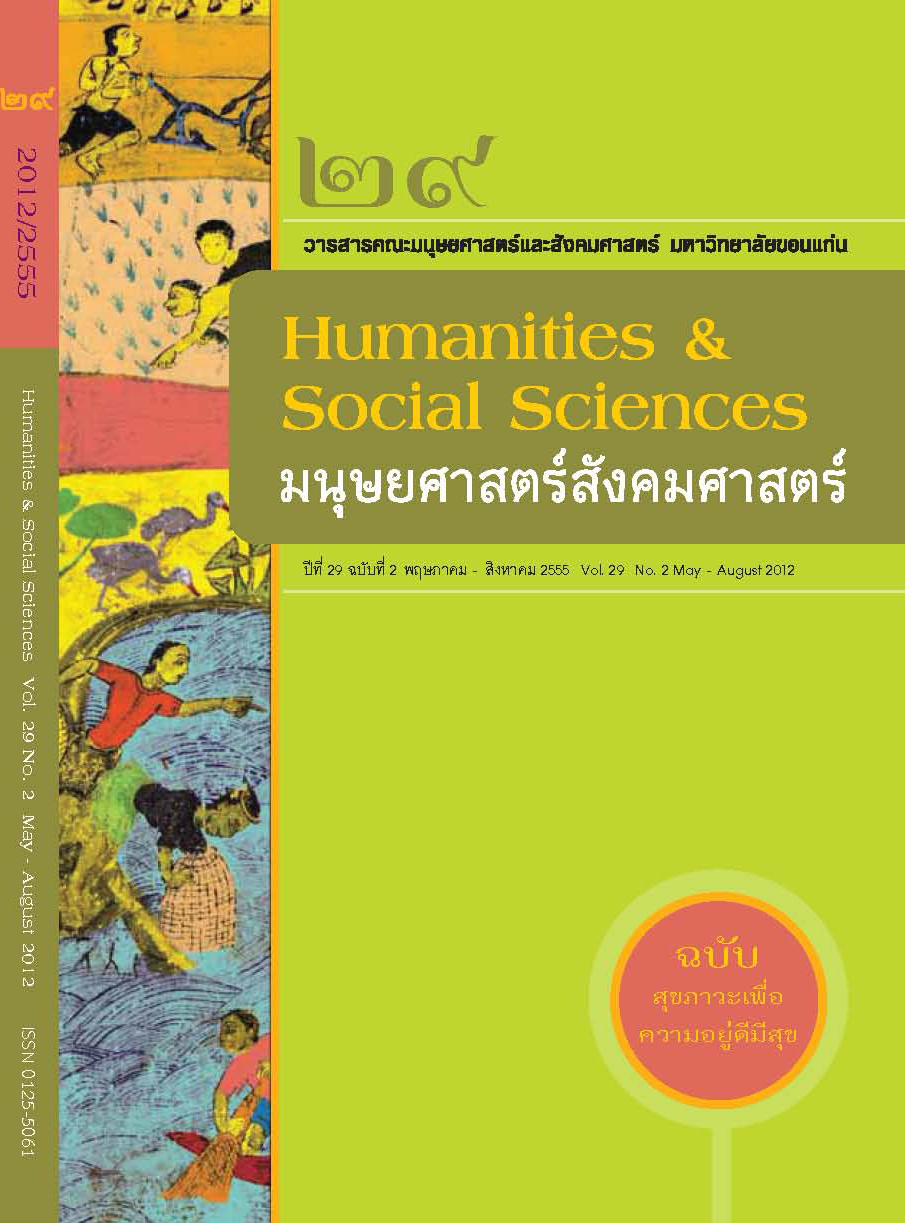สุขภาวะชุมชนเพื่อความอยู่ดีมีสุข
Abstract
บทคัดย่อ
บทความเรื่อง การพัฒนาสุขภาวะเพื่อความอยู่ดีมีสุข เป็นการวิจัยสังเคราะห์ความรู้ มีวัตถุประสงค์เพื่อเสนอทางเลือกวิธีการพัฒนาตัวชี้วัดสุขภาวะ การพัฒนาศักยภาพผู้นำองค์กรชุมชน และอบต. การพัฒนาแนวทาง วิธีการประสานงาน และการทำงานแบบมีส่วนร่วมกับ อบต. การพัฒนานวัตกรรมสร้างเสริมสุขภาวะ การพัฒนาแนวทางการสื่อสารสาธารณะด้านสุขภาวะ
ระเบียบวิธีวิจัยเป็นการวิจัยเชิงปฏิบัติการ แบบมีส่วนร่วมที่มีนักวิชาการจากภายนอก นักปฏิบัติการในชุมชน และนักวิจัยสุขภาวะชุมชน แบ่งบทบาทหน้าที่ในการวิจัย มีพื้นที่เป้าหมาย 30 ตำบล
ผลการศึกษาพบว่า ผลลัพธ์จากการสร้างเสริมสุขภาวะ สามารถบรรเทาความทุกข์ทางร่างกายและจิตใจได้บ้าง ด้านสังคม ผู้สูงอายุรู้สึกตนเองมีคุณค่า เกิดความร่วมมือกับองค์กรท้องถิ่น ด้านปัญญา เกิดการประยุกต์ใช้ภูมิปัญญา การติดอาวุธทางปัญญา วิเคราะห์หาสาเหตุ จากการการเรียนรู้ในการทำตัวชี้วัด ข้อมูล แผนที่สุขภาวะ นโยบาย ยุทธศาสตร์ และโครงการ ทำให้ชุมชน และอบต.เกิดความเข้าใจในท้องถิ่นของตนเองมากขึ้น แต่ยังไม่บรรลุผลการพัฒนาสุขภาวะเพื่อความอยู่ดีมีสุข ซึ่งต้องใช้ระยะเวลายาวนานและต้องมีระบบสนับสนุนการทำงานอย่างต่อเนื่อง เพื่อให้ชุมชน ท้องถิ่นขยายกิจกรรม จนนำไปสู่การลดหรือแก้ไขปัญหาทุกขภาวะได้อย่างยั่งยืน
การสังเคราะห์ความรู้จากกระบวนการสร้างเสริมสุขภาวะ มีดังนี้ 1) การพัฒนาตัวชี้วัดโดยชาวบ้าน ได้สร้างความรู้สึกเป็นเจ้าของปัญหาทุกขภาวะ และชาวบ้านมีความเข้าใจเรื่องสุขภาพ องค์รวมที่เชื่อมโยงกับบริบทของท้องถิ่นมากขึ้น 2) การประยุกต์ใช้แนวคิดการขับเคลื่อนนโยบายสาธารณะด้านสุขภาพโดยกลไกสามเหลี่ยมเขยื้อนภูเขา พบว่า ผู้นำชุมชนมักทำหลายบทบาทร่วมกัน ไม่ได้แยกแยะบทบาทเฉพาะด้านใดด้านหนึ่ง 3) การเสริมสร้างกระบวนการเรียนรู้ให้กับผู้นำ 3 ด้าน เป็นการพัฒนาภาวะผู้นำ และสร้างความเข้าใจในกระบวนการสร้างสุขภาวะ มีความจำเป็นที่สถาบันวิชาการต้องร่วมจัดกระบวนการเรียนรู้อย่างต่อเนื่อง 4) การมีส่วนร่วมของชุมชนกับ อบต. เริ่มจากการสร้างความสนใจ ความตระหนัก และต้องการเปลี่ยนแปลงไปสู่การมีสุขภาวะที่ดี ชุมชนและอบต.เห็นความสำคัญร่วมเป็นเจ้าของโครงการ อีกทั้งบรรจุข้อบัญญัติงบประมาณเพื่อดำเนินงาน 5) นวัตกรรมสร้างเสริมสุขภาพและแหล่งเรียนรู้ เป็นการฟื้นฟูสิ่งเก่า หรือการสร้างสิ่งใหม่ที่ดีในชุมชน ทุกตำบลมีการริเริ่มกิจกรรมสุขภาวะ บางตำบลเกิดนวัตกรรมเชื่อมโยงสู่นโยบายจังหวัด เช่น “ตำเมี่ยงสมุนไพร” ส่งผลต่อการควบคุมระดับน้ำตาลในเลือดของผู้ป่วยโรคเบาหวาน และ “การมอบลูกฝากหลาน” สลับกันเลี้ยงดูเป็นเวลา 1 เดือน ส่งผลทำให้พ่อ แม่ ผู้ปกครองและลูก มีความเข้าใจบทบาทการเป็นสมาชิกครอบครัว แสดงออกในการดูแล เอาใจใส่กันมากขึ้น เป็นต้น 6) การสื่อสารสาธารณะในชุมชน เกิดแผนที่สุขภาวะและสื่อพื้นบ้าน เป็นเครื่องมือชี้นำการสร้างนโยบาย ยุทธศาสตร์ โครงการและใช้เผยแพร่ความรู้ ความเข้าใจเรื่องสุขภาวะของชุมชนได้ดี
ข้อเสนอแนะที่สำคัญ คือ องค์กรปกครองส่วนท้องถิ่นและผู้นำสุขภาวะชุมชน ต้องนำข้อมูลมาวิเคราะห์และจัดลำดับปัญหา เพื่อจัดทำแผนและนำเข้าสู่ข้อบัญญัติของอบต. ให้มีผลทางปฏิบัติเป็นประจำทุกปี และอบต.ควรแบ่งสัดส่วนงบประมาณของท้องถิ่น สนับสนุนการสร้างสุขภาวะ
สำนักงานกองทุนสนับสนุนการสร้างเสริมสุขภาพ (สสส.) ควรสนับสนุนกระบวนการสร้างสุขภาวะอย่างเป็นระบบและต่อเนื่อง
ด้านการศึกษาวิจัยครั้งต่อไป ควรศึกษาวิจัย เรื่อง ความสัมพันธ์ระหว่างตัวชี้วัดสุขภาวะกับบริบทของพื้นที่ (แบบเมือง , แบบกึ่งเมืองกึ่งชนบท และแบบชนบท)
Abstract
The paper titled ‘Community Well-Being Development for Healthy Life’ is body of knowledge synthesis on its’ objective to have; well-being index development, community and Sub-district Administrative Organisation (SAO) leaders’ potential development, well-being innovation development, and well-being media development. The methodology employed was Participatory Action Research (PAR) in which composed of the academics, community practitioner/operators and community well-being (CWB) researchers co-worked in division of roles in 30 target Sub-districts.
The findings were the results of well-being promotion can mitigate physical and mental sufferings, and in term of social health, elderly had greater self-esteem and better collaboration in local organisations; for intelligent health, it was found the applying of intellectual learning and empowering enabling them on causes and effects analysis by learning in index setting, information & data and the well-being and health policies, strategies and projects’ implementation. The Communities and the Sub-district Administrative Organisations (SAO) have more learning on their local needs, however it was not found achievement of the quality of a healthy life in which required time and continual support systems to enable local communities and their organisations to extend their activities scope to reduce or sustainably solve problem of unhealthiness/ ill-being.
Knowledge synthesizing from well-being promotion process has; 1 Community-based well-being index development from the unhealthy/ ill-being sense of belonging and the community understanding on holistic healthiness in linking closely with local context in greater magnitude and means. 2. Application of concepts in public health policy formulation driving force by ‘mountain-move triangle mechanisms’ found community leaders play multiple roles not focusing on specific aspect of problems/issues 3. Promotion on learning process of the community leadership on major three aspects and construct understanding on well-being promotion and necessities for institutions to co-organising long term, continual learning process 4. Community-based and SAO-based to initiate interest, awareness and changes to well being seeing importance as project owner and plan for project implementation budgeting. 5 Innovation on health promotion and learning in various forms like recovering old wisdom and construct or create new good and appropriate things in community by every Sub-district has its’ own well-being activities and some sub-districts have innovative activities linking to provincial policy such as ‘Tam-miang-samunprai’ or herbs spicy salad as medicinal snack/menu which is very good for controlling sugar diabetes of local diabetes patients, and ‘Gan Mobluk Faklan’ or the rotation of families’ kids care among group of families in the period of one month, in which resulting in increasing of family kids care time, for instance. 6. Community–based media for well-being needs communication and mapping well-being local media in order to be a tool to guide and direct as a strategic policy, project undertaking and used as knowledge dissemination and good community well-being understanding.
The important recommendation is Local Administrative Organisations and well-being community leaders must analyse data and information obtained and prioritize needs and problems to plan and issuing as the SAOs’ codes of practices and mandate the codes regularly and annually. The SAOs are demanded to plan for budget allocation to support community well-being promotion.
Thai Health Promotion Foundation should support community well-being creation process systemically and continually.
The future research could be on the relation of community well-being (CWB) index and in different area context, for instances; urban, sub-urban and rural.



